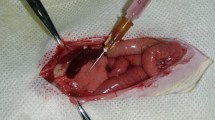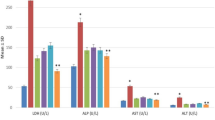Abstract
Background
Bone marrow contains hematopoietic stem cells, nonhematopoietic mesenchymal stem cells, and several precursor cells for osteoblasts, chondrocytes, adipocytes, myocytes, hepatocytes, and even neural cells. Research findings indicate that multipotent stem cells in the adult body may be used to recover the lost functions of damaged tissues. This study examined the involvement of bone marrow-derived cells in the regeneration of the stomach after experimental gastric ulcers were produced in rats.
Methods
We transplanted the bone marrow of transgenic rats that expressed green fluorescence protein (GFP) throughout the body. Twenty-one days after the bone marrow transplantation (BMT), gastric ulceration was induced, using absolute ethanol. Control animals received saline. After various observation periods, rats harboring GFP-positive bone marrow-derived cells were killed, and the tissues were removed and processed to prepare paraffin-embedded sections. Cells expressing GFP were identified by conventional immunohistochemistry, using anti-GFP antibody. To identify whether cells expressing GFP were epithelial cells or interstitial cells such as fibroblasts, serial sections were examined with anti-cytokeratin antibody or anti-vimentin antibody, respectively. Furthermore, to confirm that cells expressing GFP were epithelial cells or interstitial cells, we used double-staining analysis with anti-GFP antibody or anti-cytokeratin antibody, respectively.
Results
GFP-positive, bone marrow-derived cells were found in the cytokeratin-positive gastrointestinal epithelium, as well as among vimentin-positive interstitial cells. Interestingly, the proportions of GFP-positive, cytokeratin-positive epithelial cells and vimentin-positive interstitial cells were significantly greater in the ethanol-treated damaged stomachs than in the saline-treated controls.
Conclusions
The present study clearly demonstrates that bone marrow-derived cells are involved in the regeneration of the stomach after ethanol-induced ulcers in rats.
Similar content being viewed by others
References
ED Thomas R Storb RA Clift A Fefer L Johnson PE Neiman et al. (1975) ArticleTitleBone-marrow transplantation N Engl J Med 292 832–43 Occurrence Handle234595
ED Thomas JE Storb RA Clift A Fefer L Johnson PE Neiman et al. (1975) ArticleTitleBone-marrow transplantation N Engl J Med 292 895–902 Occurrence Handle235092
G Ferrari GCD Angelis M Coletta E Paolucci A Stornaiuolo G Cossu et al. (1998) ArticleTitleMuscle regeneration by bone marrow-derived myogenic progenitors Science 279 1528–30 Occurrence Handle9488650
EM Horwitz DJ Prockop A Fitzpatrick WWK Koo PL Gordon M Neel et al. (1999) ArticleTitleTransplantability and therapeutic effects of bone marrow-derived mesenchymal cells in children with osteogenesis imperfecta Nature Med 5 309–13 Occurrence Handle10086387
L Maraval D Modrowski AK Gupta JE Aubin (1994) ArticleTitleCellular expression of bone-related proteins during in vitro osteogenesis in rat bone marrow stromal cell cultures J Cell Physiol 158 555–72 Occurrence Handle8126078
RF Pereira KW Halford MD O’Hara DB Leeper BP Sokolov MD Pollard et al. (1995) ArticleTitleCultured adherent cells from marrow can serve as long-standing precursor cells for bone, cartilage, and lung in irradiated mice Proc Natl Acad Sci USA 92 4857–61 Occurrence Handle7761413
BE Petersen WC Bowen KD Patrene WM Mars AK Sullivan N Murase et al. (1999) ArticleTitleBone marrow as a potential source of hepatic oval cells Science 284 1168–70 Occurrence Handle1:CAS:528:DyaK1MXjtlajsL4%3D Occurrence Handle10325227
MF Pittenger AM Mackay SC Beck RK Jaiswal R Douglas JD Mosca et al. (1999) ArticleTitleMultilineage potential of adult human mesenchymal stem cells Science 284 143–7 Occurrence Handle1:CAS:528:DyaK1MXitlCnu7o%3D Occurrence Handle10102814
DJ Prockop (1997) ArticleTitleMarrow stromal cells as stem cells for nonhematopoietic tissues Science 276 71–4 Occurrence Handle9082988
B Anders S Clive (1999) ArticleTitleBreaking the brain-blood barrier Nature 397 569–70 Occurrence Handle10050848
D Orlic J Kajstura S Chimenti I Jakoniuk SM Anderson B Li et al. (2001) ArticleTitleBone marrow cells regenerate infarcted myocardium Nature 410 701–5 Occurrence Handle1:CAS:528:DC%2BD3MXivFSmsb4%3D Occurrence Handle11287958
T Ito A Suzuki E Imai M Okabe M Hori (2001) ArticleTitleBone marrow is a reservoir of repopulating mesangial cells during glomerular remodeling J Am Soc Nephrol 12 2625–35 Occurrence Handle11729231
M Brittan T Hunt R Jeffery R Poulsom SJ Forbes K Hodivala-Dilke et al. (2002) ArticleTitleBone marrow derivation of pericryptal myofibroblasts in the mouse and human small intestine and colon Gut 50 752–7 Occurrence Handle12010874
ND Theise S Badve R Saxena O Henegariu S Sell JM Crawford et al. (2000) ArticleTitleDerivation of hepatocytes from bone marrow cells in mice after radiation-induced myeloablation Hepatology 31 235–40 Occurrence Handle1:STN:280:DC%2BD3c%2FotVyktw%3D%3D Occurrence Handle10613752
E Lagasse H Connors MA Dhalimy M Reitsma M Dohse L Osborne et al. (2000) ArticleTitlePurified hematopoietic stem cells can differentiate into hepatocytes in vivo Nature Med 6 1229–34 Occurrence Handle11062533
MR Alison R Poulsom R Jeffery AP Dhillon A Quaglia J Lacob et al. (2000) ArticleTitleHepatocytes from non-hepatic adult stem cells Nature 406 257 Occurrence Handle1:CAS:528:DC%2BD3cXlsFKju74%3D Occurrence Handle10917519
ND Theise M Nimmakayalu R Gardner PB Illei G Morgan L Teperman et al. (2000) ArticleTitleLiver from bone marrow in humans Hepatology 32 11–6 Occurrence Handle1:STN:280:DC%2BD3czjtVShtQ%3D%3D Occurrence Handle10869283
CR Bjornson RL Rietze BA Reynolds MC Magli AL Vescovi (1999) ArticleTitleTurning brain into blood: a hematopoietic fate adopted by adult neural stem cells in vivo Science 283 534–7 Occurrence Handle1:CAS:528:DyaK1MXoslCgtw%3D%3D Occurrence Handle9915700
MA Eglitis E Mezey (1997) ArticleTitleHematopoietic cells differentiate into both microglia and macroglia in the brains of adult mice Proc Natl Acad Sci USA 94 4080–5 Occurrence Handle9108108
DS Krause ND Theise MI Collector O Henegariu S Hwang R Gardner et al. (2001) ArticleTitleMulti-organ, multi-lineage engraftment by a single bone marrow-derived stem cell Cell 105 369–77 Occurrence Handle1:CAS:528:DC%2BD3MXjs1aitrY%3D
M Okabe M Ikawa K Kominami T Nakanishi Y Nishimura (1997) ArticleTitleldquo;Green mice” as a source of ubiquitous green cells FEBS Lett 407 313–9 Occurrence Handle1:CAS:528:DyaK2sXivFyrsrY%3D Occurrence Handle9175875
H Niwa K Yamamura J Miyazaki (1991) ArticleTitleEfficient selection for high-expression transfectants with a novel eukaryotic vector Gene 108 193–9 Occurrence Handle1660837
R Okamoto T Yajima M Yamazaki T Kanai M Mukai S Okamoto et al. (2002) ArticleTitleDamaged epithelia regenerated by bone marrow-derived cells in the human gastrointestinal tract Nature Med 8 1011–7 Occurrence Handle12195435
AJ Wagers RI Sherwood JL Christensen IL Weissman (2002) ArticleTitleLittle evidence for developmental plasticity of adult hematopoietic stem cells Science 297 2256–9 Occurrence Handle1:CAS:528:DC%2BD38XntlWltrY%3D Occurrence Handle12215650
N Terada T Hamazaki M Oka M Hoki DM Mastalerz Y Nakano et al. (2002) ArticleTitleBone marrow cells adopt the phenotype of other cells by spontaneous cell fusion Nature 416 542–5 Occurrence Handle1:CAS:528:DC%2BD38XivVOntLk%3D Occurrence Handle11932747
QL Ying J Nichols EP Evans AG Smith (2002) ArticleTitleChanging potency by spontaneous fusion Nature 416 545–8 Occurrence Handle1:CAS:528:DC%2BD38XivVOntb4%3D Occurrence Handle11932748
X Wang H Willenbring Y Akkari Y Torimaru M Foster M Al-Dhalimy et al. (2003) ArticleTitleCell fusion is the principal source of bone-marrow-derived hepatocytes Nature 422 823–5 Occurrence Handle12712184
A Saiura M Sata M Washida Y Sugawara Y Hirata R Nagai et al. (2003) ArticleTitleLittle evidence for cell fusion between recipient and donor-derived cells J Surg Res 113 222–7 Occurrence Handle12957133
E Marshman C Booth CS Potten (2002) ArticleTitleThe intestinal epithelial stem cell Bioessays 24 91–8 Occurrence Handle11782954
M Tatematsu H Fukami M Yamamoto H Nakanishi T Masui M Kusakabe et al. (1994) ArticleTitleClonal analysis of grandular stomach carcinogenesis in C3H/HeN⇔BALB/c chimeric mice treated with N-methyl-N-nitrosourea Cancer Lett 83 37–42 Occurrence Handle8062232
M Tatematsu T Masui H Fukami M Yamamoto H Nakanishi K Inada et al. (1996) ArticleTitlePrimary monoclonal and secondary polyclonal growth of colon neoplastic lesions in C3H/HeN↔BALB/c chimeric mice treated with 1,2-dimethylhydrazine: immunohistochemical detection of C3H strain-specific antigen and simple sequence length polymorphism analysis of DNA Int J Cancer 66 234–8 Occurrence Handle8603817
Author information
Authors and Affiliations
Rights and permissions
About this article
Cite this article
Komori, M., Tsuji, S., Tsujii, M. et al. Efficiency of bone marrow-derived cells in regeneration of the stomach after induction of ethanol-induced ulcers in rats. J Gastroenterol 40, 591–599 (2005). https://doi.org/10.1007/s00535-005-1593-0
Received:
Accepted:
Issue Date:
DOI: https://doi.org/10.1007/s00535-005-1593-0




